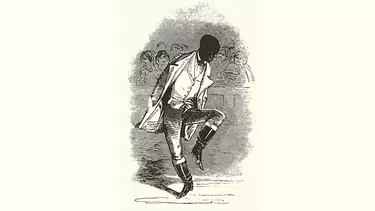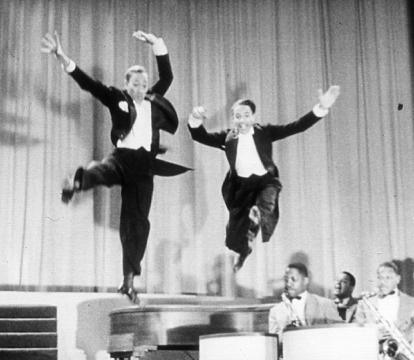A history of tap dancing
Leaping off tabletops and singing penguins: moments in the dance's rich history
To celebrate The Tap Pack’s debut at the Sydney Opera House we’re taking a walk—and a dance—down memory lane with history’s iconic tap moments.
While tap emerged as an offshoot of jazz, it’s an artform that hasn’t had the spotlight of other styles of dance. It endured the racism of segregation, took itself from Broadway to film, and even became the preferred dance for animated penguins.
Here are the moments that made tap history:
Bojangles and Shirley Temple
‘Staircase Dance’
Bill “Bojangles” Robinson is recognised as the face of tap dance to this day. The jovial, wide-smiling servant of six-year-old Shirley Temple and her Southern plantation family caught the eye of Hollywood, but performing at the time meant fighting against the racism of Jim Crow-era segregation. Black actors were not allowed to perform with white performers unless, like Shirley, they were children. Later in life, Shirley confessed she never realised the discrimination her on-screen partner faced.
Robinson was a revolutionary, not just for artists but for black people. Even though it was banned, Robinson performed with other black artists, including George W. Cooper. At the time, white “minstrels” as well as black artists wore blackface, but Robinson refused throughout his entire career.
He was instrumental in the foundation of the Negro Actors Guild of America, a groundbreaking organisation that emerged during the Harlem Renaissance fighting for black representation in film and on the stage. The organisation lasted through to the 1980s, with Robinson being instrumental in fundraising concerts on Broadway.
Watch Staircase Dance on YouTube.
Master Juba
You could say that Master Juba, born William Henry Lane, was the inventor of tap. Creating what we call ‘tap’ today, Juba imitated and evolved the dances he saw from his time: foot stamping, thigh slapping, hand clapping and traditional Irish dance. In the early 19th century, he was one of the first and only free black performers to travel America, yet his performances were still only for white crowds.

‘Jumpin Jive’ by The Nicholas Brothers
It’s been called the greatest dance sequence ever filmed—a big call, but when you see the highly acrobatic and daring dance innovations of the Nicholas Brothers their impressive moves cannot be denied.
If you agree, you’re in good company: ballet legend Mikhail Baryshnikov said they were “the most amazing dancers I have ever seen in my life—ever”, and Fred Astaire called the Jumpin Jive “the greatest dance number ever filmed”.
Watch Jumpin Jive on YouTube.
Gregory Hines
Throughout the ‘80s and ‘90s, Gregory Hines became the definition of classical tap. His grace on stage, jaunty steps and ease on stage made him a figure of the scene. He was an advocate, lobbying successfully for National Tap Dance Day (25 May). He mentored an entire generation of dancers, from Dianne ‘Lady Di’ Walker and Savion Glover.
Watch a clip of Gregory Hines on Youtube.
Savion Glover (or, Mumble in Happy Feet)
The former protege of Gregory Hines revitalised tap for the contemporary world with a political bent. He used his dancing to pay homage to the dance’s history: Bojangles, Sammy Davis Jr. and Lon Chaney, the original Phantom of the Opera.
He danced heavy and hard-footed, different from the ‘joyous’ tap dancing of Gene Kelly and Fred Astaire. Glover was immortalised in choreography and motion capture as the penguin ‘Mumble’ from Happy Feet.
Watch a clip from Happy Feet on YouTube.
‘Moses Supposes’
from Singin' in the Rain (1952)
Singin' in the Rain was only a modest hit at the box office on first release. It’s since acquired legendary status and stood the test of time. There are too many tap routines to mention in this film but a stand-out moment is the song and dance number ‘Moses Supposes’. The tongue twister speech lesson meets tap extravaganza is a high energy dance number, with perfectly in sync movements by Gene Kelly and Donald O’Connor who quickly turn their elocution teacher into a prop of their own.
‘Twelve Days of Christmas’ at Radio City Christmas Spectacular, The Rockettes
Known for long legs and precision dance moves the Radio City Hall Rockettes worked countless hours and underwent a rigorous audition process to ensure perfection. Can you imagine 36 near identical women standing in line kicking over one thousand times a day? You don’t have to—see them dance “Twelve Days of Christmas” on Youtube.
